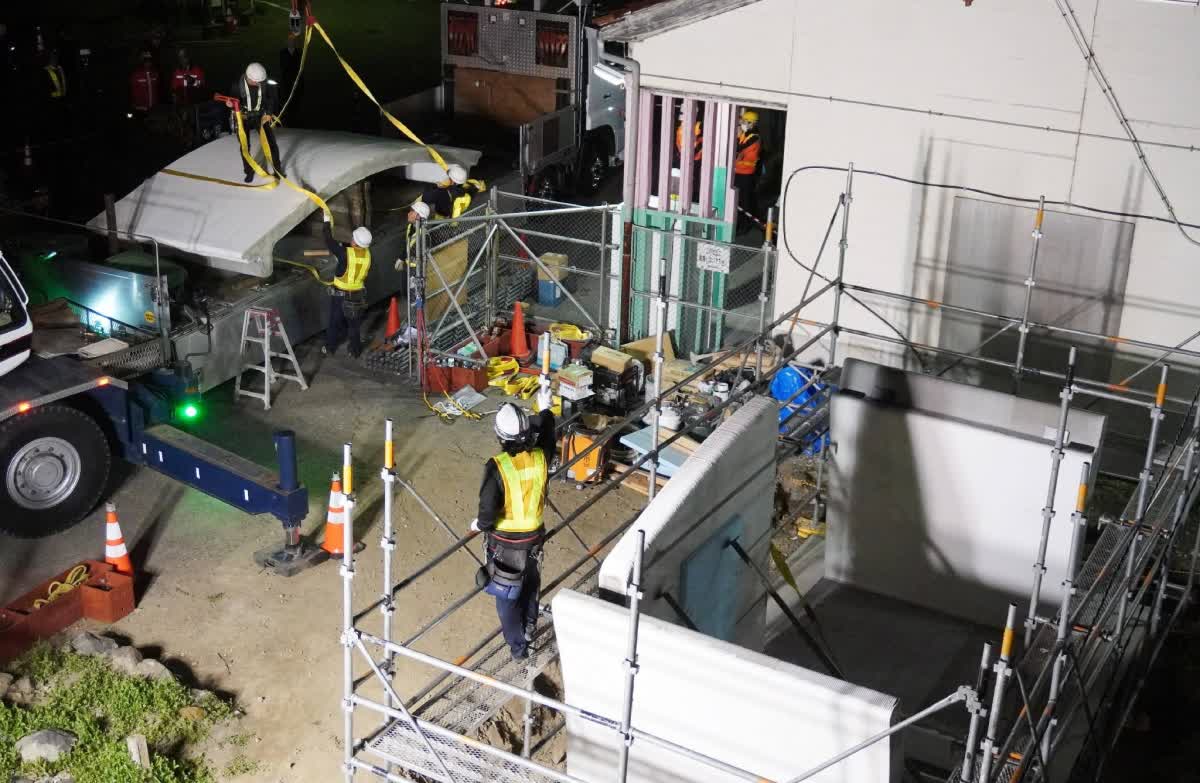What simply occurred? West Japan Railway Firm (JR West) has unveiled what it claims to be the world’s first 3D-printed practice station constructing. Situated at Hatsushima Station on the JR Kisei Predominant Line in Arida, Wakayama Prefecture, the mission merges cutting-edge know-how with cultural sensitivity, marking a possible milestone in railway infrastructure.
The brand new station constructing, set to open in July, replaces an growing older picket construction that had served the agricultural group for years. Standing 2.6 meters tall, 6.3 meters large, and a couple of.1 meters deep, the single-story bolstered concrete constructing was constructed utilizing superior 3D printing know-how.
Japanese 3D-printing building specialist Serendix prefabricated 4 key parts, together with the roof and partitions, off-site. These have been then transported and assembled in simply two and a half hours, throughout the window between the final practice at night time and the primary practice the next morning.
The method concerned shaping mortar with a 3D printer and creating formwork to mildew the outside. Reinforcing metal was inserted into the hole sections earlier than being crammed with concrete, guaranteeing sturdiness and earthquake resistance corresponding to conventional bolstered concrete constructions, with out the necessity for typical picket or steel formwork.
JR West estimates this strategy cuts prices by round 50 % in comparison with typical bolstered concrete buildings.

Past value financial savings, this speedy building technique reduces disruptions to railway operations, making it a great answer for changing growing older infrastructure on energetic rail strains.
The station’s design displays its native environment, that includes creative depictions of Arida Metropolis’s iconic mikan oranges and tachiuo (beltfish) on the outside. JR West emphasised that the purpose is to create a station cherished by residents whereas aligning with regional tradition, an strategy they describe as “regional coexistence.”
Hatsushima Station was chosen for the pilot as a result of its coastal location, permitting specialists to guage the construction’s resilience towards environmental challenges corresponding to salty air publicity. Moreover, JR West will assess long-term upkeep prices and feasibility as a part of its broader plan to modernize Japan’s railway infrastructure.
If profitable, JR West plans to increase 3D printing know-how throughout its community. The corporate sees this innovation as key to its long-term imaginative and prescient of offering “secure, safe, and human-friendly transportation” whereas enhancing sustainability.
Picture credit score: JIJI
What simply occurred? West Japan Railway Firm (JR West) has unveiled what it claims to be the world’s first 3D-printed practice station constructing. Situated at Hatsushima Station on the JR Kisei Predominant Line in Arida, Wakayama Prefecture, the mission merges cutting-edge know-how with cultural sensitivity, marking a possible milestone in railway infrastructure.
The brand new station constructing, set to open in July, replaces an growing older picket construction that had served the agricultural group for years. Standing 2.6 meters tall, 6.3 meters large, and a couple of.1 meters deep, the single-story bolstered concrete constructing was constructed utilizing superior 3D printing know-how.
Japanese 3D-printing building specialist Serendix prefabricated 4 key parts, together with the roof and partitions, off-site. These have been then transported and assembled in simply two and a half hours, throughout the window between the final practice at night time and the primary practice the next morning.
The method concerned shaping mortar with a 3D printer and creating formwork to mildew the outside. Reinforcing metal was inserted into the hole sections earlier than being crammed with concrete, guaranteeing sturdiness and earthquake resistance corresponding to conventional bolstered concrete constructions, with out the necessity for typical picket or steel formwork.
JR West estimates this strategy cuts prices by round 50 % in comparison with typical bolstered concrete buildings.

Past value financial savings, this speedy building technique reduces disruptions to railway operations, making it a great answer for changing growing older infrastructure on energetic rail strains.
The station’s design displays its native environment, that includes creative depictions of Arida Metropolis’s iconic mikan oranges and tachiuo (beltfish) on the outside. JR West emphasised that the purpose is to create a station cherished by residents whereas aligning with regional tradition, an strategy they describe as “regional coexistence.”
Hatsushima Station was chosen for the pilot as a result of its coastal location, permitting specialists to guage the construction’s resilience towards environmental challenges corresponding to salty air publicity. Moreover, JR West will assess long-term upkeep prices and feasibility as a part of its broader plan to modernize Japan’s railway infrastructure.
If profitable, JR West plans to increase 3D printing know-how throughout its community. The corporate sees this innovation as key to its long-term imaginative and prescient of offering “secure, safe, and human-friendly transportation” whereas enhancing sustainability.
Picture credit score: JIJI














